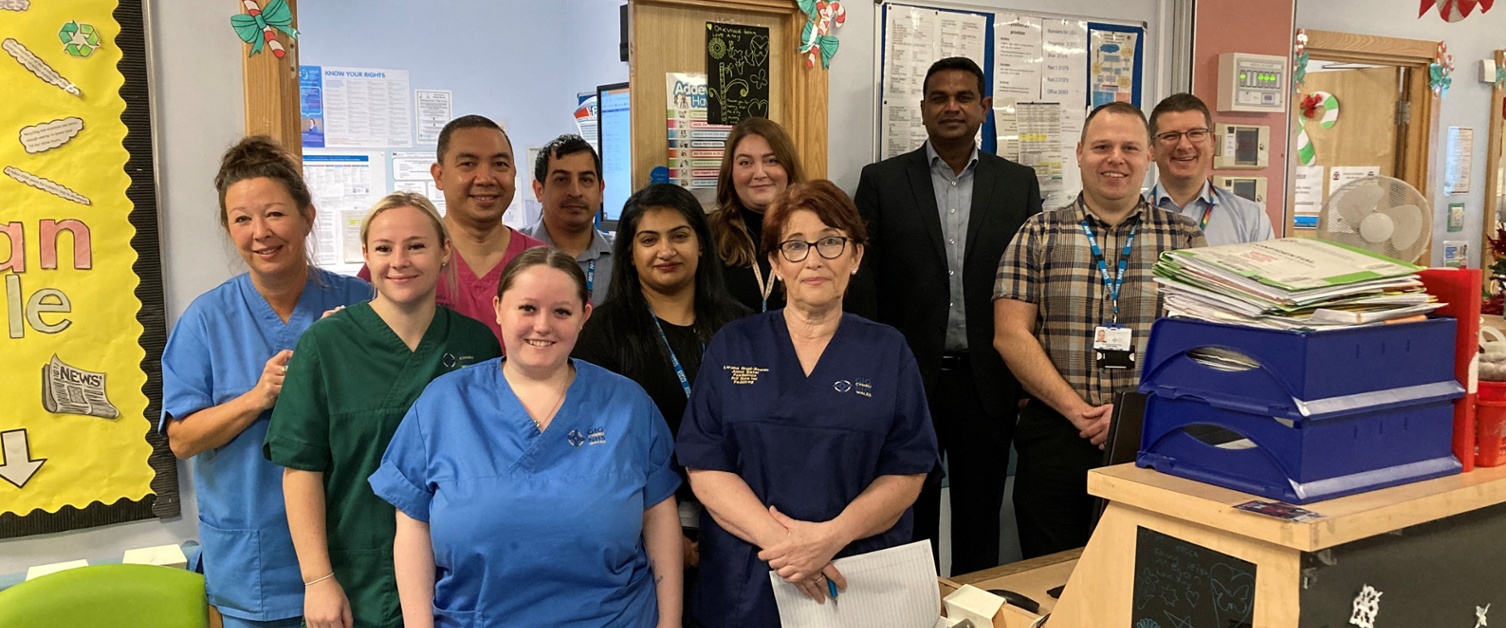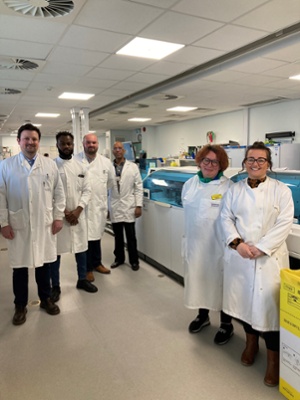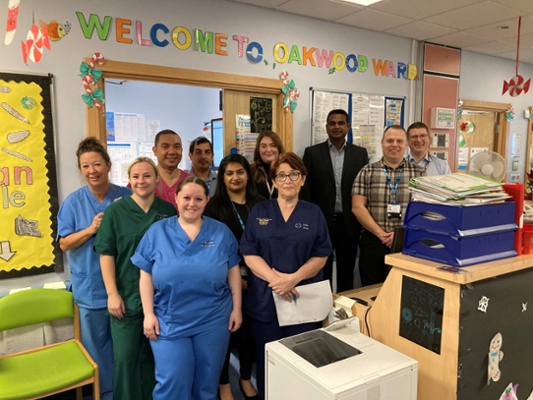Going digital proves shot in the arm for blood test results

Switching the paper process to a digital system is helping deliver more efficient blood test results with fewer mistakes.
A number of health board services have taken on a process called Electronic Test Requesting (ETR), which is a key component of a Welsh Government drive to modernise pathology services.
 ETR is replacing the paper form and allows clinicians to request pathology tests via the Welsh Clinical Portal (WCP), giving staff access to an all-Wales digital health record.
ETR is replacing the paper form and allows clinicians to request pathology tests via the Welsh Clinical Portal (WCP), giving staff access to an all-Wales digital health record.
Benefits of the digital system include improved patient safety through the reduction of errors from illegible handwriting, along with cutting delays caused by other mistakes on paper forms.
PICTURED: Laboratory Medicine staff (from left) James Lesniak, Nnamdi Bede Aneke, Matthew Strangward, Sunny Rajkumar, Catrin Hammond and Vickie Scrine.
It also allows the clinician to view previous results and outstanding requests from both primary and secondary care before ordering the next test, reducing unnecessary duplicate testing.
Having already widely integrated the system across Swansea Bay, the health board’s paediatric service is next in line to fully embrace the change following an initial pilot. It will be put in place across its sites in Morriston, Singleton and Neath Port Talbot.
Paediatric Consultant Pramodh Vallabhaneni is leading the service’s integration of ETR. He said: “Our department has been successful in implementing ETR in outpatients. The change has been positive, and now we are heading towards putting the inpatient ETR process in place. I must say a big thanks to our nursing colleagues, consultants and managerial colleagues who have all been enablers of the change process.
“This is a win-win for patients and staff as it has so many benefits. We have embraced ETR as it is something which we feel benefits both patients and clinicians.”
 Collaboration between the health board’s pathology department and digital services team has led to a successful roll out of ETR across a number of Swansea Bay services.
Collaboration between the health board’s pathology department and digital services team has led to a successful roll out of ETR across a number of Swansea Bay services.
Angharad Shore, Clinical Scientist and Andar Gunneberg, Consultant Chemical Pathologist and Clinical Lead for Laboratory Medicine, highlighted the importance of moving to the digital system.
PICTURED: Lowri Cassell-Powell, Kayleigh Rogers, Steph Gwytha, Loraine Brant-Bowen, Jojo Padilla, Juber Islam, Mahmona Khushi, Laura McKelvie-Seth, Pramodh Vallabhaneni, David Wade and Gareth O'Gorman have embraced the new ETR system.
Angharad said: “This has been an important milestone in the ETR implementation project. ETR has the significant benefit of improved data quality for samples received by the laboratory for analysis, which in turn leads to reduced errors, improved clinical governance and ultimately improved patient safety.”
Andar added: “In Swansea Bay, 77% of all secondary care requests and 89% of primary care requests are made via ETR.
“Paediatric ETR uptake is a significant step towards the target of more than 95% to be achieved by February 2025 to avoid serious operational difficulties when the new Laboratory Information Management System (LIMS) is implemented.”
David Wade, Digital Services Implementation and Support Officer, said: “ETR is already the primary way of requesting pathology investigations across adult in-patient areas as well as the Emergency Department and Acute Medical Unit, and we are working closely with the pathology department to improve our uptake for ETR across the health board.
“Following a period of laboratory configuration, testing and validation of the paediatric ETR process, Pramodh and his paediatric colleagues undertook a successful pilot in Singleton’s paediatric outpatient setting, and now that is being implemented across the main hospitals.
“This collaborative approach to change has yielded positive results and it’s something we’re looking to develop further throughout the health board.
“The services who have taken on ETR have found it is a more efficient and safer method than the paper option.”
Rydym yn croesawu gohebiaeth a galwadau ffôn yn y Gymraeg neu'r Saesneg. Atebir gohebiaeth Gymraeg yn y Gymraeg, ac ni fydd hyn yn arwain at oedi. Mae’r dudalen hon ar gael yn Gymraeg drwy bwyso’r botwm ar y dde ar frig y dudalen.
We welcome correspondence and telephone calls in Welsh or English. Welsh language correspondence will be replied to in Welsh, and this will not lead to a delay. This page is available in Welsh by clicking ‘Cymraeg’ at the top right of this page.